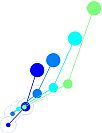Behavioral and neural mechanisms driving joint decision-making are key to understanding foraging and economic choices in social species. Unlike classical game-theoretical paradigms, many social interactions unfold in real-time with direct face-to-face visibility. We have shown that the probability of seeing a partner's action before making one's own decision shapes successful strategies in evolutionary simulations, e.g. in a transparent Bach-or-Stravinsky (BoS) dyadic economic game [1]. This game incentivizes coordination but also includes an inherent conflict about which of the two coordinated options to select. Under naturalistic conditions of mutual action visibility—when the game is played on a two-sided transparent touchscreen—macaques learn to follow a “predictable” human confederate who alternates between blocks of selecting either own or macaque's preferred option, and use this knowledge to coordinate when paired with each other [2].
In primates, the premotor cortex has been implicated in representing the actions of others, but its role in dynamic social interactions remains unclear. Here, we explore the neural correlates of dynamic coordination using implanted arrays in the ventral and dorsal premotor cortex while two macaques played a similar game, making spatial reach decisions alone (“Solo” condition) or before/simultaneously/after a predictable or unpredictable human partner or conspecific (“Dyadic” condition). Most cells were spatially selective in both conditions, but action sequence primarily influenced activity in the dyadic condition, suggesting that the premotor cortex integrates information about a partner's actions. Monkeys coordinated effectively when they could observe their partner's choices and were also able to anticipate predictable choices when required to act before the partner. Population-level decoding of monkey spatial choices indicated that post-action activity incorporated anticipation of the partner's choice. When monkeys acted first, the predictable partner's upcoming choice could be decoded even before the partner's action, with decoding accuracy further enhanced after observing the action. Coordination outcome (“same/different” targets) could only be decoded after the second action (either the monkey's or partner's) was evident. This decoding was strongest for an unpredictable partner and weakest for an irrelevant partner, indicating modulation based on relevance to expected reward. However, the value of the selected target was not decodable. In contrast, during a passive observation condition—where monkeys received a reward based on the partner's choice but did not act—the representation of the partner's spatial choice was limited, while the representation of expected value was stronger. Thus, the premotor cortex emphasizes relevant task dimensions, integrating predictions and observations of others' actions with one's own goals and choices during dynamic strategic coordination.
[1] Unakafov AM, Schultze T, Gail A, Moeller S, Kagan I, Eule S, Wolf F (2020) Emergence and suppression of cooperation by action visibility in transparent games. PLoS Comput Biol 16(1): e1007588. https://doi.org/10.1371/journal.pcbi.1007588
[2] Moeller S, Unakafov AM, Fischer J, Gail A, Treue S, Kagan I (2023) Human and macaque pairs employ different coordination strategies in a transparent decision game. eLife 12: e81641. https://doi.org/10.7554/eLife.81641

 PDF version
PDF version
